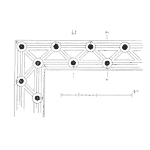
Absolutely not! That is a big misconception of the process. You get to decide how broadly or how narrowly you apply Reliability Centered Maintenance.
Read moreYour Reliability Engineering Professional Development Site
Find all articles across all article series listed in reverse chronological order.
by Nancy Regan Leave a Comment

Absolutely not! That is a big misconception of the process. You get to decide how broadly or how narrowly you apply Reliability Centered Maintenance.
Read moreby Karl Burnett Leave a Comment

British writers often marvelled at the quality and longevity of Roman roads, wondering how modern engineers and governments could hope to imitate their success. The fascination with Roman roads continues, and an excellent overview by Richard Brushi is available on Medium.com.
[Read more…]by Sanjeev Saraf Leave a Comment

RAGAGEP stands for Recognized And Generally Accepted Good Engineering Practices.
Specifically, OSHA 29 CFR 1910.119 (D)(3)(ii) states:The employer shall document that equipment complies with recognized and generally accepted good engineering practices.
EPA RMP also refers to RAGAGEP in 40 CFR 68.73:Inspection and testing procedures shall follow recognized and generally accepted good engineering practices. [Read more…]
by Robert (Bob) J. Latino Leave a Comment

Have you ever thought about all the many elements of a successful maintenance/reliability initiative? It is the alphabet soup of acronyms. RCA, RCM, FMEA, ODR, CMMS, EAM, BOM, KPI, MRO, PdM, PM, IIoT … The list goes on and on. The problem is that while many of these elements are critical to implementing a successful asset performance management (APM) initiative, it is overwhelming for those tasked with doing it at the plant level. There is a tendency to want to apply all these tools and technologies to all areas of the plant at the same time.
by James Reyes-Picknell 1 Comment

I approach problems with computer systems in a fairly critical way, but I am not anti-CMMS/EAM technology. I am, however, anti-waste. All too often I see a lot of time, effort, and money going into technology that simply doesn’t provide a return on the investment. When it comes to Maintenance data – it is often problematic and unfit for many of its intended purposes. Aside from helping to administer work orders, these systems often provide little business value. Does a small saving in administrative cost and time really justify the millions often spent on these systems?
[Read more…]by Mike Sondalini Leave a Comment

A robust Maintenance Planning and Scheduling Process uses a Scheduled Work Crew capacity planned days ahead with planned jobs. And it has a small Quick Response Crew of people capable to handle any random job.
A great Maintenance Planning and Scheduling Process design separates reactive work from jobs that can be planned and scheduled. This article explains how to re-engineer a maintenance planning and scheduling process to handle reactive and planned jobs.
[Read more…]by Greg Hutchins Leave a Comment

We obtain information through learning to become, hopefully, knowledgeable and this is achieved through the communication of data. This communication is achieved through our five senses despite a belief by some in a mystical third-eye and the gifts of telepathy and ESP.
Mankind’s communication abilities depend on sight, hearing, touch, taste and smell. This basic toolbox of senses has been augmented, or some say ‘lessened’, over millennia through education and the evolution of culture and technology as our civilizations rise, and eventually, fall.
[Read more…]
Working with data, we often choose a model to represent that data. We then use the data to estimate the parameters of the chosen model and we then calculate a confidence interval about the model’s parameters. The confidence interval gives us a numerical assessment of how certain we are, based on our data, of the true value of the distribution parameter we estimated.
[Read more…]by Carl S. Carlson Leave a Comment

“Most of us spend too much time on what is urgent, and not enough time on what is important.” – Steven Covey
FMEAs take time and cost money. If time is wasted, FMEAs will be unsupported and ineffective.
In this article, I’ll lay out some tips to keep FMEA in-meeting time as short as possible, without reducing the quality of results. Many of these tips are based on lessons learned from doing FMEAs the wrong way. This is not a complete list. I’m sure you have other lessons learned to save time, and would love to hear from you.
by Sanjeev Saraf Leave a Comment

On the morning of July 19, a fire in CITGO’s Corpus Christi refinery injured a worker. The incident occurred in the alkylation unit of the refinery.
The refinery used Hydrogen Fluoride (HF) as a catalyst for alklyation . Typically in the alkylation process, isobutane and olefins are combined (in presence of HF) to produce a high-octane chemical used in premium gasoline.
[Read more…]by Michael Pfeifer, Ph.D., P.E. Leave a Comment

Metal strength and fracture toughness are important mechanical properties for components exposed to fatigue conditions and components with stress concentrations. Optimization of the two properties through alloy selection and component fabrication must be considered when designing components for these situations.
For structural components, strength and fracture toughness are two important mechanical properties. Yield strength is the stress a metal can withstand before deforming. Tensile strength is the maximum stress a metal can support before starting to fracture. Fracture toughness is the energy required to cause a material that contains a crack to fracture.
[Read more…]by Robert (Bob) J. Latino Leave a Comment

Most associate the traditional application of RCA, with some type of undesirable outcome, that has exceeded a set threshold or trigger. It is at this point that a formal RCA process will be set into motion. Because of its serious nature, it will likely have the attention and support of leadership. It may also have the attention of external stakeholders like OEM’s, insurance companies and regulators. As a career ‘RCA’ professional, I must say that this traditional perception unfortunately is the norm, and not the exception in my 35+ years in this space. This is unfortunate because it suppresses the methodology’s potential, and the capability of applying a more holistic approach to preventing such undesirable outcomes in the first place. In this article my intent is to provide a different perspective of how to view ‘RCA’ in a much broader and meaningful context and coupling its use with an effective Defect Elimination (DE) strategy. While most are familiar with hindsight-based RCA, we will explore the emergence of foresight approaches as well. We will also contrast these perspectives in an effort to truly understand WHY we even do RCA, and is it worthwhile?
[Read more…]
[Read more…]We are facing difficulty in developing a definition of Critical Spare Part Inventory. No one is able to define it in its true essence. The situation is further confused with the difference to strategic spare parts. Any guideline or standard where we can find it ?
In the past, every Plant Manager had their own definition of Critical Inventory which changed with time. In optimization of Inventory, the first step is to establish a definition of Inventory considering all factors like production loss, redundancy, safety hazard, failure frequency, and of course, the lead time? Still I am stuck in this phase. I cannot progress, and don’t know what to do 1st, 2nd, and so forth to proceed further in this journey?
by Greg Hutchins Leave a Comment

Greg Carroll has a graduate degree in Operations Research from Swinburne University. He has a certificate in Machine Learning from Stanford University and in Data Science from the University of Michigan. He has over thirty years’ experience in Enterprise Risk Management. He has applied risk management techniques to IT and Artificial Intelligence systems in mission critical environments like the Department of Defense and Victorian Infectious Disease Reference Laboratories.
[Read more…]by Mike Sondalini Leave a Comment

In some industries, 40% of maintenance repairs result from original equipment manufacturing failures. And up to 35% of maintenance is traceable to design engineering mistakes. That totals 75% of maintenance costs during operation can be from prior life cycle process blunders
To get utmost operating plant and equipment reliability, you need to purposefully design and build your business processes to guarantee maximum reliability from each and every phase of the asset life cycle
[Read more…]